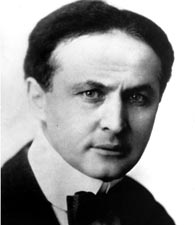During his short career, Harry Houdini’s “death-defying” feats astonished his audiences. People from all walks of life came to watch Houdini escape from shackles, milk cans and water tanks. Their fascination with his act continued his legacy long after his untimely death.
Harry Houdini’s Early Days
Born as Erik Weisz on March 24, 1874, Houdini spent the first four years of his childhood in Budapest, Hungary, before immigrating to the United States with his parents and four siblings in 1878. After settling in Appleton, Wis., young “Ehrie” (Harry) moved with his father, a rabbi, to New York City.
It was in New York that Ehrie first began to cultivate his passion for magic. The young man was burdened with numerous jobs to help support his family back in Wisconsin, but he still found the time to make his debut as a trapeze artist. The trapeze act led him to take on magic professionally.
In 1891, he took the stage name “Harry Houdini,” a name inspired by his admiration for magician Jean Eugene Robert-Houdin. Along with his younger brother, Theodore, who was also fascinated with magic, Houdini began performing regularly when he was just a teenager.
Sources in this Story
- Library of Congress: Houdini: A Biographical Chronology
- PBS: The American Experience: Houdini
- Encyclopedia.com: Harry Houdini
- Appleton Public Library: Ferber Interviews Houdini
- MSNBC: One final trick for Houdini: exhumation
Houdini’s Notable Accomplishments
Houdini’s lackluster magic career took off in 1899 after vaudeville theater owner Martin Beck witnessed Houdini escaping from handcuffs during a performance. Beck advised Houdini to focus on escape acts in lieu of magic tricks, and gave him the opportunity to perform on vaudeville tours, a step up from the dime museums he had been playing. A tour through Europe in 1900 furthered advanced his career, transforming him into a star,
Houdini amazed the public with his ability to escape from milk cans, water tanks and straitjackets. He wasn’t the first to escape from locked handcuffs, but his presentation beat all other magicians’ and delighted audiences. His first successful stage trick, however, wasn’t an escape trick—it was the needle trick. He would swallow several needles and some thread, and then regurgitate them with all the needles threaded.
In July 1904, Edna Ferber, the first female reporter for the newspaper the Appleton Crescent, interviewed Houdini. “Now, don’t you exaggerate just a little bit when you are giving your performances?,” she asked him, continuing, “And is it a feat of strength, or a trick that you resort to?”
Houdini reportedly responded good-naturedly that exaggeration could never help him in his magic. “My secret?” he said. “Well certainly it is a trick of my own. No house or bank would be safe from prying hands if I revealed it to the world.”
Learn about Houdini’s 1926 escape from an underwater coffin.
The Man and His Work
- “Houdini on Magic” by Harry Houdini
- “Houdini: Unlocking The Mystery” by The History Channel
- “The Secret Life of Houdini” by William Kalush and Larry Sloman
- “Death Defying Acts” by Gillian Armstrong
The Rest of the Story
Harry Houdini died on Halloween in 1926, apparently from injuries sustained during a performance when a college student repeatedly punched him in the stomach, testing his abdominal strength. But an autopsy was never performed and mysteries surround the performer’s death; many have suggested over the years that Houdini was murdered by poisoning.
This story was originally written by Cara McDonough; it was updated February 16, 2017.











